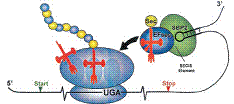Biochemistry, Department of

Vadim Gladyshev Publications
Document Type
Article
Date of this Version
2008
Abstract
Background: Selenium (Se) is a trace element that occurs in proteins in the form of selenocysteine (Sec) and in tRNAs in the form of selenouridine (SeU). Selenophosphate synthetase (SelD) is required for both utilization traits. However, previous research also revealed SelDs in two organisms lacking Sec and SeU, suggesting a possible additional use of Se that is dependent on SelD.
Results: In this study, we conducted comparative genomics and phylogenetic analyses to characterize genes involved in Se utilization. Candidate genes identified included SelA/SelB and YbbB that define Sec and SeU pathways, respectively, and NADH oxidoreductase that is predicted to generate a SelD substrate. In addition, among 227 organisms containing SelD, 10 prokaryotes were identified that lacked SelA/SelB and YbbB. Investigation of selD neighboring genes in these organisms revealed a SirA-like protein and two hypothetical proteins HP1 and HP2 that were strongly linked to a novel Se utilization. With these new signature proteins, 32 bacteria and archaea were found that utilized these proteins, likely as part of the new Se utilization trait. Metabolic labeling of one organism containing an orphan SelD, Enterococcus faecalis, with 75Se revealed a protein containing labile Se species that could be released by treatment with reducing agents, suggesting non-Sec utilization of Se in this organism.
Conclusion: These studies suggest the occurrence of a third Se utilization trait in bacteria and archaea.


Comments
Published in BMC Genomics 2008, 9:251. Copyright © 2008 Zhang et al; licensee BioMed Central Ltd. Used by permission.